MPLS Layer 3 VPN (L3VPN) Notes
MPLS Layer 3 VPN (L3VPN)

MP-BGP
– Multiprotocol Border Gateway Protocol
PE
– Provider Edge router
P
– Provider router
CE
– Customer Edge router
Control Plane
– PE – CE
-> IGP or eBGP
– PE – PE
-> MP-BGP
Data Plane
– When traffic will be sent, MPLS will be used
PE routers create one VRF (Virtual Routing and Forwarding) instance per customer
– VRF has a separate FIB table per customer
– VRF parameters
-> Name of VRF table
-> Route Distinguisher (RD)
-> 64 bit value represented as <32 bit>:<32 bit>
-> 50:60
-> Used to make customer routes unique
RD + IPv4 address = VPNv4 router
-> 64 bit + 32 bits = 96 bits
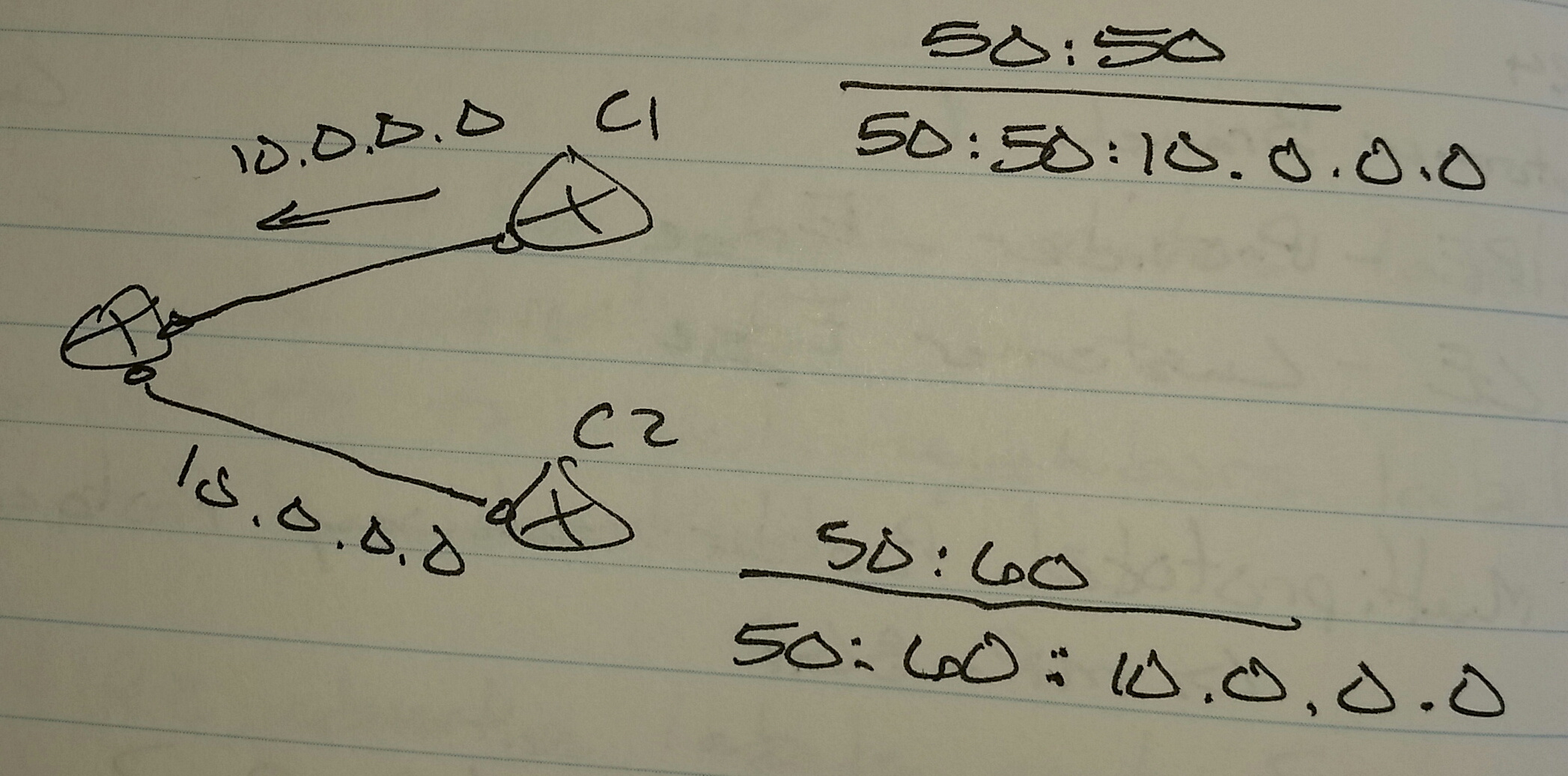
-> Route Target (RT)
-> 64 bit value represented as <32 bit>:<32 bit>
-> To control the distination of routes, the concept of import and export is used
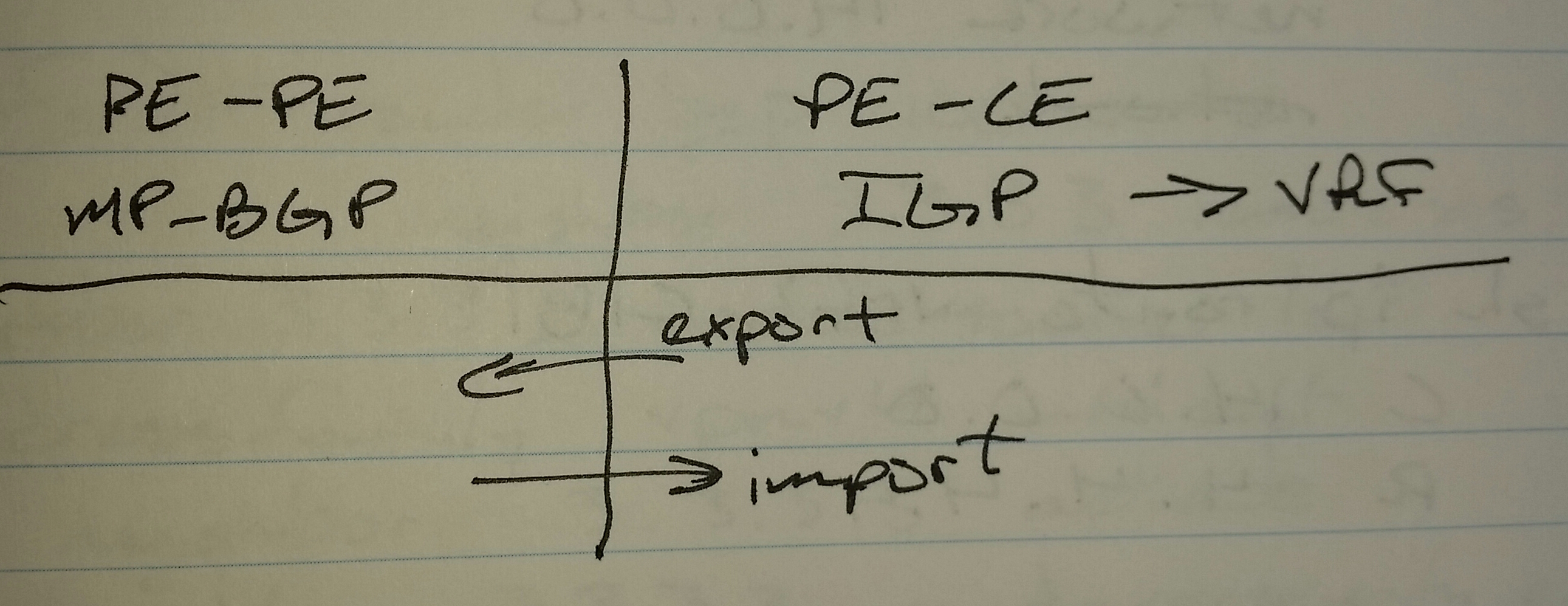
Configuration on PE routers
Phase 1
1. Create the VRF
2. Adding RD value
-> Only one RD value per VRF
3. One or more RTs
-> Import
-> Export
4. Interface association with the VRF
5. PE – CE protocol association
R1 (config)# ip vrf c1b1
rd 100:100
route-target import 100:100
route-target export 100:100
int s0/0
ip vrf forwarding c1b1
ip add 14.0.0.1 255.0.0.0
sh ip route
C 12.0.0.0
C 1.0.0.0
sh ip route vrf c1b1
C 14.0.0.0
R1(config)# router rip
address-family ipv4 vrf c1b1
version 2
no auto-summary
network 14.0.0.0
sh ip route vrf c1b1
C 14.0.0.0
R 4.4.4.4
Configure RIP on the CE routers
After Phase 1, the PE routers will have the local client routes
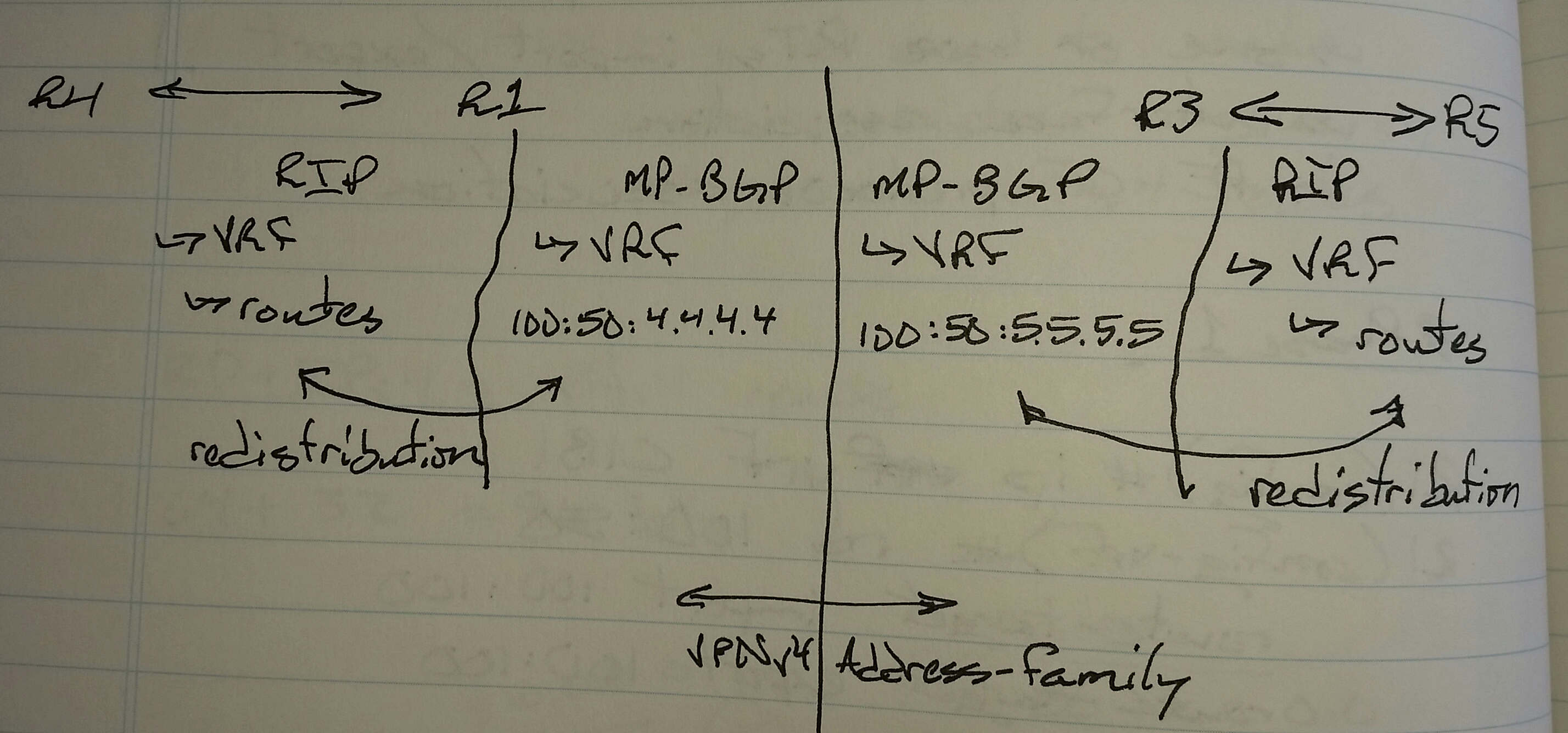
Phase 2
1. Configure MP-BGP on PE routers
2. Form VPNv4 neighbor relationship between PE routers using /32 loopback interfaces
3. Do mutual redistribution between the PE – CE IGP and the MP-BGP VRF-to-VRF
RD + IPv4 Address = VPNv4 route
100:100:4.4.4.4
R1(config)# router bgp 100
neighbor 3.3.3.3 remote-as 100
neighbor 3.3.3.3 update-source lo0
address-family vpnv4 unicast
neighbor 3.3.3.3 activate
neighbor 3.3.3.3 send-community extended
-> This is automatically added to the configuration when the neighbor is activated
address-family ipv4 vrf c1b1
redistribute rip
Extended community is used to send and receive IGP parameters from one customer site to another customer site
R1(config)# router rip
address-family ipv4 vrf c1b1
redistribute bgp 100 metric { transparent | <value> }
Transparent
RIP -> BGP’s MED -> BGP’s MED -> RIP metric

BGP adds a VPN label when routes are redistributed into BGP
BGP VPN Label = 100 for 4.4.4.4
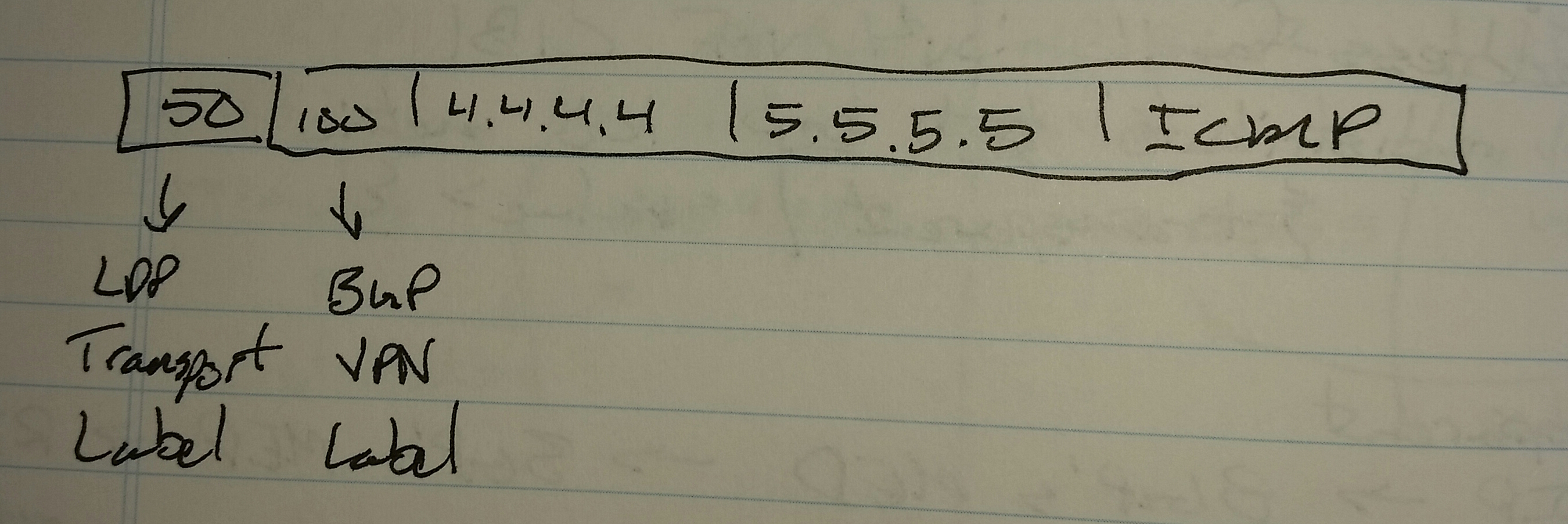
sh mpls forwarding-table
-> To check the LFIB
BGP
– IPv4
– IPv6
XR Routers
router bgp <asn>
address-family <afi> <safi>
-> Address-family Identifier
-> ipv4
-> 32 bit
-> ipv6
-> 128 bit
-> vpnv4
-> RD + ipv4
-> 64 bits + 32 bits = 96 bits
-> Client IPv4 addresses
-> vpnv6
-> RD + ipv6
-> 64 bits + 128 bits = 192 bits
-> Client IPv6 addresses
-> Subsequent Address-family Identifier
-> unicast
-> multicast
-> mdt
-> Multicast Distribution Tree
router bgp <asn>
address-family <afi> <safi>
network <ip add>/<nm>
redistribute <protocol>
exit
neighbor <ip add>
remote-as <asn>
update-source <int>
ebgp-multihop <ttl>
address-family <afi> <safi>
route-reflector-client
next-hop-self
route-policy <name> in | out
as-override
default-originate

Configure BGP between R1 and R2 for IPv4 and IPv6
– Advertise loopbacks
– Disable the default address-familty
-> This is commonly seen in the lab
R1(config)# router bgp 100
no bgp default ipv4-unicast
neighbor 12.0.0.2 remote-as 100
neighbor 2002:12::2 remote-as 100
address-family ipv4 unicast
neighbor 12.0.0.2 activate
network 12.0.0.0 mask 255.0.0.0
network 1.1.1.1 mask 255.255.255.255
address-family ipv6 unicast
neighbor 2002:12::2 activate
network 2002:12::/64
network 2002:1:1:1::1/128
R2(config)# router bgp 100
-> On the XR router, the is no default address-family
address-family ipv4 unicast
network 2.2.2.2/32
network 12.0.0.0/8
address-family ipv6 unicast
network 2002:12::/8
network 2002:2:2:2::2/128
neighbor 12.0.0.1
remote-as 100
address-family ipv4 unicast
neighbor 2002:12::1
remote-as 100
address-family ipv6 unicast
sh bgp <afi> <safi>
sh bgp ipv4 unicast
sh bgp ipv6 unicast
eBGP
– By default, no IPv4 or IPv6 updates can be exchanged
-> A route-policy has to be applied to the incoming and outgoing directions inside the address-family
– Create the route-policy in global config
route-policy PASS
pass
exit
– Apply the route-policy to the address-family
router bgp 100
neighbor <ip add>
address-family <afi> <safi>
route-policy PASS in
route-policy PASS out
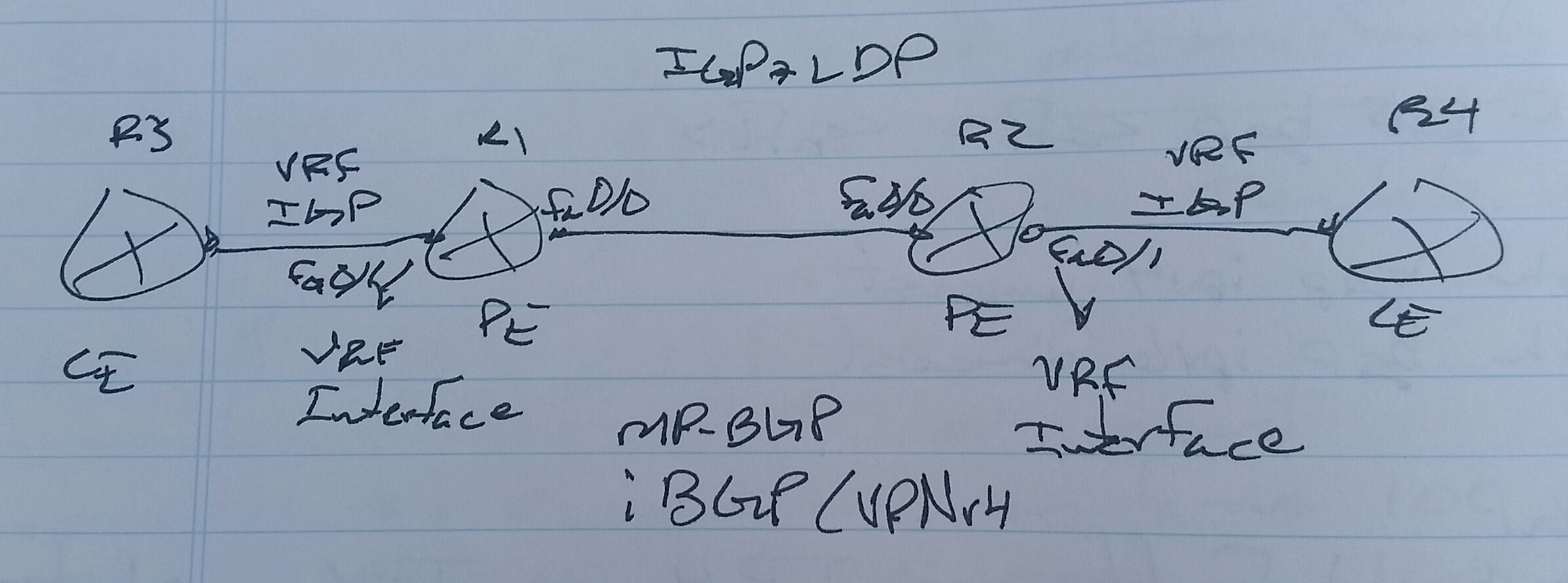

L3VPN
1. VRF creation
2. PE – CE interface association
3. IGP association ( PE – CE )
4. MP-BGP ( PE – PE )
5. Mutual redistribution between VRF IGP and MP-BGP
– ISP Core
-> IGP + LDP
XR Routers
R1(config)# vrf ABC
address-family ipv4 unicast
import route-target 1:1
export route-target 1:1
RD value is configured inside BGP on XR routers
– This is easy to forget
VRF interface association
– On XR routers, the IPv4 and IPv6 addresses must be removed before associating the interface to the VRF
R1(config)# int g0/0/0/0
no ipv4 add
no ipv6 add
vrf ABC
ipv4 <ip add>/<nm>
ipv6 <ip add>/<nm>
router rip
vrf ABC
int g0/0/0/0
router eigrp 100
vrf ABC
address-family ipv4 unicast
autonomous-system 100
int g0/0/0/0
address-family ipv6 unicast
autonomous-system 100
int g0/0/0/0
router ospf 1
vrf ABC
area 0
int g0/0/0/0
root
show config
commit
MP-BGP
– VPNv4 address-family
-> PE – PE
– Mutual redistribution with VRF IGP
R1(config)# router bgp 100
address-family ipv4 unicast
address-family vpn4 unicast
neighbor 2.2.2.2
remote-as 100
update-source lo0
address-family vpn4 unicast
vrf ABC
rd 1:1
-> This is easy to forget
address-family ipv4 unicast
redistribute ospf 1
router ospf 1
vrf ABC
redistribute bgp 100
area 0
int g0/0/0/0
During the SP lab, there will be 6 PE routers and 6 CE routers
If PE – CE protocol is BGP
R1(config)# router bgp 100
address-family ipv4 unicast
address-family vpnv4 unicast
neighbor 2.2.2.2
remote-as 100
update-source lo0
address-family vpnv4 unicast
vrf ABC
rd 1:1
address-family ipv4 unicast
redistribute connected
neighbor 13.0.0.3
remote-as 50
address-family ipv4 unicast
route-policy PASS in
route-policy PASS out
as-override
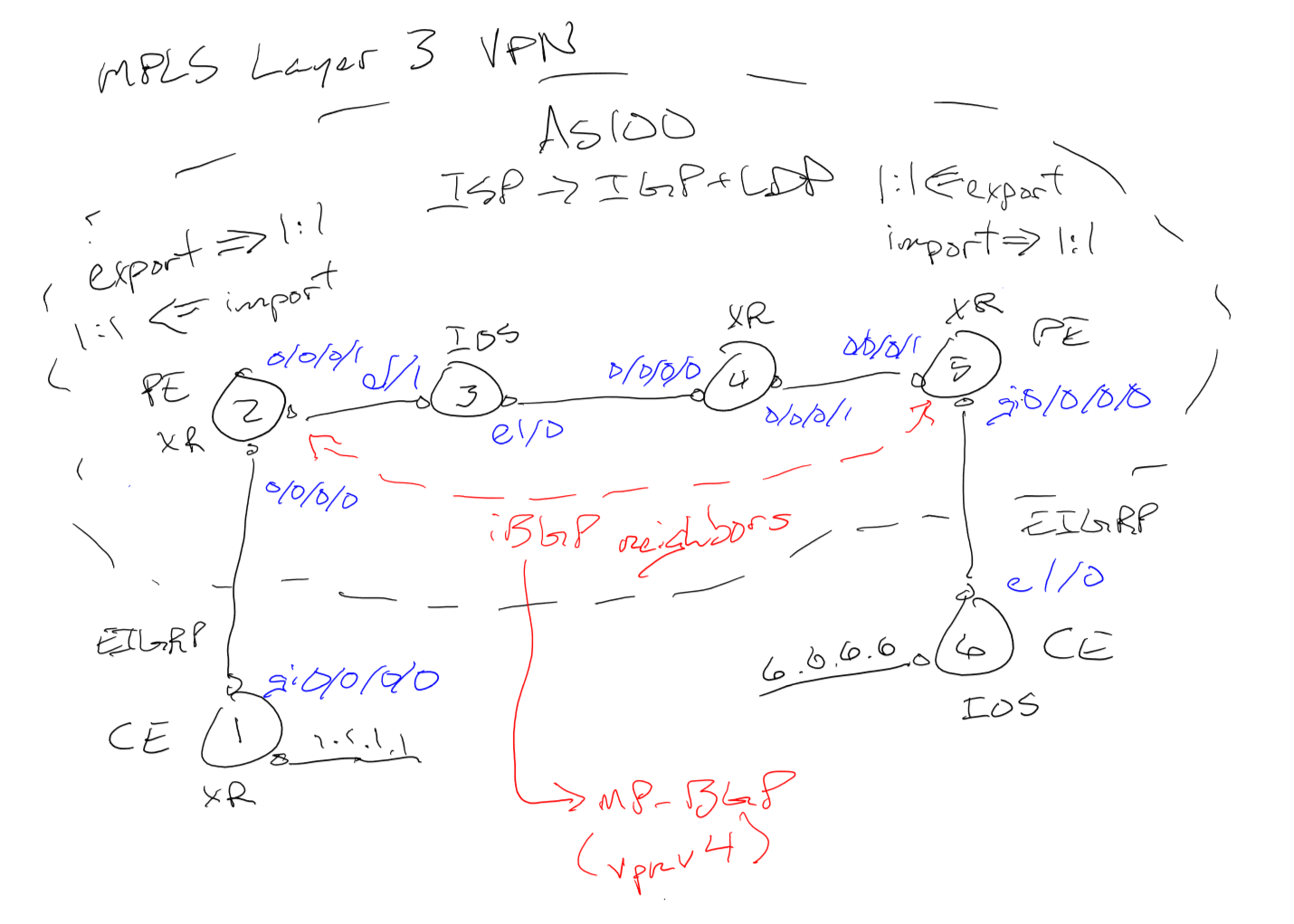
! R1
router eigrp 1
address-family ipv4
int lo0
int gi0/0/0/1
! R2
router ospf 1
router-id 2.2.2.2
area 0
int lo0
int gi0/0/0/1
!
mpls ldp
router ospf 1
mpls ldp auto-config
!
router bgp 100
bgp router-id 2.2.2.2
address-family vpnv4 unicast
neighbor 5.5.5.5
remote-as 100
update-source lo0
address-family vpnv4 unicast
!
vrf ABC
address-family ipv4 unicast
import route-target 1:1
export route-target 1:1
router bgp 100
vrf ABC
rd 1:1
address-family ipv4 unicast
!
int g0/0/0/0
no ipv4 address 12.0.0.2 255.255.255.0
vrf ABC
ipv4 address 12.0.0.2 255.255.255.0
!
router eigrp 1
vrf ABC
address-family ipv4
autonomous-system 1
int gi0/0/0/0
!
router bgp 100
vrf ABC
address-family ipv4 unicast
redistribute eigrp 1
router eigrp 1
vrf ABC
address-family ipv4
redistribute bgp 100
! R3
int lo0
ip ospf 1 area 0
int e1/0
ip ospf 1 area 0
int e1/1
ip ospf 1 area 0
router ospf 1
router-id 3.3.3.3
!
mpls label protocol ldp
mpls ldp router-id lo0 force
int e1/0
mpls ip
int e1/1
mpls ip
! R4
router ospf 1
router-id 4.4.4.4
area 0
int lo0
int gi0/0/0/0
int gi0/0/0/1
!
mpls ldp
router ospf 1
mpls ldp auto-config
! R5
router ospf 1
router-id 5.5.5.5
area 0
int lo0
int gi0/0/0/1
!
mpls ldp
router ospf 1
mpls ldp auto-config
!
router bgp 100
bgp router-id 5.5.5.5
address-family vpnv4 unicast
neighbor 2.2.2.2
remote-as 100
update-source lo0
address-family vpnv4 unicast
!
vrf ABC
address-family ipv4 unicast
import route-target 1:1
export route-target 1:1
router bgp 100
vrf ABC
rd 1:1
address-family ipv4 unicast
!
int gi0/0/0/0
no ipv4 address 35.0.0.3 255.255.255.0
vrf ABC
ipv4 address 35.0.0.3 255.255.255.0
!
router eigrp 1
vrf ABC
address-family ipv4
autonomous-system 1
int gi0/0/0/0
!
router bgp 100
vrf ABC
address-family ipv4 unicast
redistribute eigrp 1
router eigrp 1
vrf ABC
address-family ipv4
redistribute bgp 100
! R6
router eigrp 1
network 6.6.6.6 0.0.0.0
network 56.0.0.6 0.0.0.0
Verification
! R1
sh eigrp int
sh eigrp nei
sh ip route
ping 6.6.6.6
! R2 and R5
sh ospf nei
sh route ospf
sh mpls int
sh mpls ldp nei bri
sh bgp vpnv4 u sum
sh bgp vpnv4 u
sh vrf ABC
sh eigrp vrf ABC nei
sh route vrf ABC eigrp
ping vrf ABC 1.1.1.1
ping vrf ABC 6.6.6.6
sh bgp vrf ABC
sh route vrf ABC bgp
sh eigrp vrf ABC topology
! R6
sh ip eigrp int
sh ip eigrp nei
sh ip route
ping 1.1.1.1

